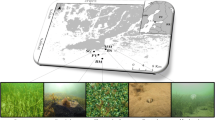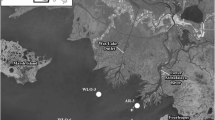Summary
The structure and metabolism of a soft-sediment estuarine macrofaunal community were measured over an annual cycle at two depth-contours in mesohaline Chesapeake Bay. Additional data for plankton productivity and respiration, as well as seston and sediment organics are also summarized for these communities. Benthic community respiration ranged from 0.24–3.38 g O2 m-2 d-1, and significant differences were detected between the two depths. Similarly, macroinfaunal standing stocks reached 11.2 and 32.3 g (ash free) m-2 for 3 m and 6 m depth communities, respectively, and both exhibited mid-summer declines in abundance. Inferences drawn from these data facilitated a partitioning of benthic community respiration into macrofaunal and meiofaunal/microbial components with a residual term, much of which could be explained statistically by interactions between these two components. A multi-variate statistical model developed from these data matched benthic respiration measurements within 1–2 S.E. Mass-balances of organic carbon were estimated for water column and benthos at the two depthcontours for early and late summer, as well as for an entire, time-weighted year. These various analyses led to the tentative conclusions that this benthic community was regulated by such internal factors as macrofaunal/meiofaunal grazing and “microbial gardening”, and by external factors such as temperature and predation by nekton. However, it appears that the ultimate control for this community was the supply of energy from organic carbon.
Similar content being viewed by others
References
Arntz WE (1977) Results and problems of an “unsuccessful” benthos cage experiment (western Baltic). In: BF Keegan, P O' Ceidigh and PJS Boaden (eds) Biology of benthic organisms. London-New York: Pergamon Press, pp 31–34
Banse K, Nichols FH, May DR (1971) Oxygen consumption by the seabed. III. On the role of macrofauna at three stations. Vie Milieu Suppl 22:31–52
Barsdate RJ, Fenchel T, Prentki RT (1974) Phosphorus cycle of model ecosystems: Significance for decomposer food chains and effects of bacterial grazers. Oikos 25:239–251
Bell SS, Coull BC (1978) Field evidence that shrimp predation regulates meiofaina. Oecologia (Berl) 35:141–148
Boynton WR, Kemp WM, Osborne CG, Kaumeyer KR (1978) Metabolic characteristics of the water column, benthos and integral community in the vicinity of Calvert Cliffs, Chesapeake Bay. Ref. No. UMCEES 78-139-CBL, Chesapeake Biological Laboratory, Solomons, MD. pp 67
Briggs KB, Tenore KR, Hanson RB (1979) The role of macrofauna in detrital utilization by the polychaete, Nereis succinea. J exp Mar Biol Ecol 36:225–234
Carey AG Jr (1967) Energetics of the benthos of Long Island Sound. I. Oxygen utilization of sediment. Bull. Bingham Oceanogr Coll 19:136–144
Cargo DG, Biggs RB (1969) Comments on hydrographic phenomena in the Chesapeake Bay, with special reference to the Calvert Cliffs nuclear power plant. Ref. No. NRI 69-106, Chesapeake Biological Laboratory, Solomons, MD pp 12
Connell JH (1975) Some mechanisms producing structure in natural communities: A model and evidence from field experiments. In: Ecology and evolution of communities. ML Cody and JM Diamond (eds). Cambridge: Harvard Univ. Press, pp 460–490
Ehrlich PR, Birch LC (1967) The “balance of nature” and “population control”. Amer Nat 101:97–107
Fenchel T, (1969) The ecology of marine meiobenthos IV. Structure and function of the benthic ecosystem, its chemical and physical factors and the microfauna communities with special reference to the ciliate protozoa. Ophelia 6:1–182
Fenchel T (1970) Studies on the decomposition of organic detritus derived from the turtle grass, Thalassis testudinum. Limnol Oceanogr 15:14–20
Fenchel T, Harrison P (1976) The significance of bacterial grazing and mineral cycling for the decomposition of particulate detritus. In: JM Anderson, A Macfadyen (eds) The role of terrestrial and aquatic organisms in decomposition process. Oxford: Blackwell Sci Publ, pp 285–300
Gaarder T, Gran HH (1927) Investigations of the production of plankton in the Oslo Fjord. Rapp. et Proc.-Verb., Cons Internat Explor Mer 42:1–48
Gerlach SA (1971) On the importance of marine meiofauna for benthic communities. Oecologia (Berl)6:176–190
Gerlach SA (1978) Food chain relationships in subtidal silty sand marine sediments and the role of meiofauna in stimulating bacterial productivity. Oecologia (Berl) 33:55–69
Hairston NG, Smith FE, Slobodkin LB (1960) Community structure, population control, and competition. Amer Nat 94:421–425
Hale SS (1975) The role of benthic communities in the nitrogen and phosphorus cycles of an estuary. In: FG Howell, JB Gentry MH Smith (eds) Mineral cycling in southeastern ecosystems. Springfield, VA: National Techn Info Serv (CONF-740513) pp 291–308
Hall CAS, Moll R (1975) Methods of assessing aquatic primary production. In: A. Leith, R Whitaker (eds) Primary production of the biosphere. Springer, Berlin Heidelberg New York, pp 19–53
Hargrave BT (1969a) Similarity of oxygen uptake by benthic communities. Limnol Oceanogr 14:801–805
Hargrave BT (1969b) Epibenthic algal production and community respiration in the sediments of Marion Lake. J Fish Res Bd Canada 26:2004–2026
Hargrave BT (1970) The effect of a deposit-feeding amphipod on the metabolism of benthic microflora. Limnol Oceanogr 15:21–30
Hargrave BT (1973) Coupling carbon flow through some pelagic and benthic communities. J Fish Res Board Can 30:1317–1326
Harris RP (1972) Seasonal changes in the meiofauna population of an intertidal sand beach. J Mar Biol Ass UK 52:389–403
Heinle DR, Taft JL, D'Elia CF, Wilson JS, Cole-Jones M, Vivian AB (1980) Historical review of water quality and climatic data in Chesapeake Bay with emphasis on effects of enrichment. Publ No. 84, Chesapeake Research Consortium, Annapolis, MD
Holland AF, Mountford NK, Mihursky JA (1977) Temporal variation in upper bay mesohaline benthic communities: I. The 9-m mud habitat. Chesapeake Sci 18:370–378
Holland AF, Mountford NK, Hiegel M, Kaumeyer K, Cargo D, Mihursky JA (1978) Results of benthic studies at Calvert Cliffs. Ref. No. CC-78-2 Martin Marietta Corp., Baltimore, MD. and Ref. No. 78-165-CBL Chesapeake Biological Laboratory, Solomons, MD. pp 120
Holland AF, Mountford NK, Hiegel MH, Kaumeyer KR, Mihursky JA (1980) The influence of predation on infaunal abundance in upper Chesapeake Bay. Marine Biol 57:221–235
Hylleberg J (1975) Selective feeding by Abarenicola pacifica with notes on Abarenicola vagabunda and a concept of gardening in lugworms. Ophelia 14:113–137
Jenkins MC, Boynton WR (1978) Selected structural and functional aspects of estuarine benthic communities. Ref. No. 78-85-CBL. Chesapeake Biological Laboratory, Solomons, MD
Kemp WM, Boynton WR (1980) Influence of biological and physical factors on dissolved oxygen dynamics in an estuarine system: Implications for measurement of community metabolism. Estuarine Coastal Mar Sci 11:407–431
Kennedy VS, Mihursky JA (1972) Effects of temperature on the respiratory metabolism of three Chesapeake Bay bivalves. Chespeake Sci 13:1–22
Kofoed LH (1975) The feeding biology of Hydrobia ventrosa. I. The assimilation of different components of the food. J exp mar Biol Ecol 19:233–241
Mann KH (1972) Macrophyte production and detritus food chains in coastal waters. Mem 1st Ital Idrobiol Suppl 29:353–383
McIntyre AD (1964) Meiobenthos of sublittoral muds. J Mar Biol Ass UK 44:665–674
Menzel DE, Vaccaro RF (1964) The measurement of dissolved organic and particulate carbon in seawater. Limnol Oceanogr 9:138–142
Mihursky JA (ed) (1978) Ecological effects of nuclear steam electric station operations on estuarine systems. Sixth progress report to U.S. Energy Research and Development Agency. Ref. No. 77-27-CBL. Chesapeake Biological Laboratory, Solomons, MD
Mihursky JA, Homer ML, Holland AF (1979) Trophic relationships of demersal fish communities in the Calvert Cliffs, Maryland, Chesapeake Bay area. Estuarine Research Federation Conf. Jekyll Is., GA. (Abstract)
Mountford NK, Holland AF, Mihursky JA (1977) Identification and description of macrobenthic communities in the Calvert Cliffs region of the Chesapeake Bay. Chesapeake Sci 18:360–369
Murdoch WW (1966) “Community structure, population control, and competition” — A critique. Amer Nat 100:219–226
Newcombe CL, Horne WA (1938) Oxygen-poor waters of the Chesapeake Bay Science 88:80–81
Newcombe CL, Horne WA, Shephard BB (1939) Studies on the physics and chemistry of estuarine waters in Chesapeake Bay. J Mar Res 11:87–116
Newell RC (1965) The role of detritus in the nutrition of two marine deposit-feeders, the prosobranch Hydrobia ulvae and the bivalve Macoma balthica. Proc Zool Soc, London 144:25–45
Nichols FH (1975) Dynamics and energetics of three deposit-feeding benthic invertebrate populations in Puget Sound, Washington. Ecol Monogr 45:57–82
Nixon SW (1980) Remineralization and nutrient cycling in coastal marine ecosystems. In: B Neilson, LE Cronin (eds) Nutrient enrichment in estuaries. Humana Press (in press)
Nixon SW, Kelly JR, Furnas BN, Oviatt CA (1980) Phosphorus regeneration and metabolism of coastal marine bottom communities. In: KR Tenore, BC Coull (eds) Marine benthic dynamics. Columbia: Univ South Carolina Press (in press)
Orth RJ (1977) The importance of sediment stability in seagrass communities. In: BC Coull (ed) Ecology of marine benthos. Columbia: Univ South Carolina Press, pp 281–300
Osborne CG, Kaumeyer KR, Keefe CW, Boynton WR, Kemp WM (1979) Community metabolism and nutrient dynamics of the Patuxent Estuary interacting with Chalk Point Power Plant. Ref. No. UMCEES 79-8-CBL, Chesapeake Biological Laboratory, Solomons, MD
Pamatmat MM (1968) Ecology and metabolism of a benthic community on an intertidal sandflat. Int Revue ges Hydrobiol 53:211–298
Pamatmat MM (1977) Benthic community metabolism: A review and assessment of present status and outlook. In: BC Coull (ed) Ecology of marine benthos. Columbia: Univ South Carolina Press, pp 89–111
Pritchard DW (1967) Observations of circulation in coastal plain estuaries. In: GH Lauff (ed) Estuaries, Publ. No. 83: Washington: Amer Assoc Adv Sci, pp 37–44
Reise K (1977) Predator exclusion experiments in an intertidal mud flat. Holgolander wiss Meeresunters 30:263–271
Rhoads DC (1974) Organism-sediment relations on the muddy sea floor. Oceanogr Mar Biol Ann Rev 12:263–300
Rhoads DC, McCall PL, Yingst JY (1978) Disturbance and production on the estuarine seafloor. Amer Scientist 66:577–586
Ryther JH (1956) The measurement of primary production. Limnol Oceanogr 1:72–84
Sanders HL (1958) Benthic studies in Buzzards Bay. I. Animal-sediment relationships. Limnol Oceanogr 3:245–258
Slobodkin LG, Smith FE, Hairston NG (1967) Regulation in terrestrial ecosystems, and the implied balance of nature. Amer Nat 101:109–124
Smith KL (1971) Structural and functional aspects of a sublittoral community. Ph.D. Thesis. Athens: Univ Georgia, pp 194
Smith KL (1973) Respiration of a sublittoral community. Ecology 54:1065–1075
Smith KL (1978) Benthic community respiration in the N.W. Atlantic Ocean: in situ measurements from 40 to 5,200 m. Mar Biol 47:337–347
Smith KL, Rowe GT, Nichols JA (1973) Benthic community respiration near the Woods Hole sewage outfall. Estuarine Coastal Mar Sci 1:65–70
Stanier RY, Duodoroff M, Adelberg EA (1970) The microbial world (Third Ed.). Englewood Cliffs, NJ: Prentice-Hall
Strickland JDH, Parsons TR (1972) A practical handbook of seawater analysis. Bull. 167 (2nd edition). Ottawa: Fish Res Bd Canada
Tenore KR, Tietjen JH, Lee JJ (1977) Effect of meiofauna on incorporation of aged eelgrass, Zostera marina, detritus by the polychaete, Nephthys incisa. J Fish Res Bd Can 34:563–567
Tietjen JH (1969) The ecology of shallow water meiofauna in two New England estuaries. Oecologia (Berl) 2:251–291
Virnstein RW (1977) The importance of predation by crabs and fishes on benthic infauna in Chesapeake Bay Ecology 58:1199–1217
Virnstein RW (1978) Predator caging experiments in soft sediments: caution advised. In: ML Wiley (ed) Estuarine interactions. New York-San Francisco-London: Academic Press, pp 261–273
Virnstein RW (1979) Predation on estuarine infauna: Response patterns of component species. Estuaries 2:69–86
Wiegert RG, Owen DF (1971) Trophic structure, available resources and population density in terrestrial versus aquatic eco-systems. J Theor Biol 30:69–81
Yetka JE, Wiebe WJ (1974) Ecological application of antibiotics as respiratory inhibitors of bacterial populations. Appl Microbiol 28:1033–1039
Young DK, Young MW (1977) Community structure of the macrobenthos associated with seagrass of the Indian River Estuary, Florida. In: BC Coull (ed) Ecology of marine benthos. Columbia: Univ South Carolina Press, pp 359–381
Young DK, Young MW (1978) Regulation of species densities of seagrass-associated macrobenthos: Evidence from field experiments in the Indian River estuary, Florida. J Mar Res 36:569–593
Author information
Authors and Affiliations
Additional information
Contribution No. HPEL-1206, USA
Supported by grants with the Maryland Department of Natural Resources (PS-72-02(77-78)), J.A. Mihursky, Coordinating Principal Investigator
Rights and permissions
About this article
Cite this article
Kemp, W.M., Boynton, W.R. External and internal factors regulating metabolic rates of an estuarine benthic community. Oecologia 51, 19–27 (1981). https://doi.org/10.1007/BF00344646
Received:
Issue Date:
DOI: https://doi.org/10.1007/BF00344646




